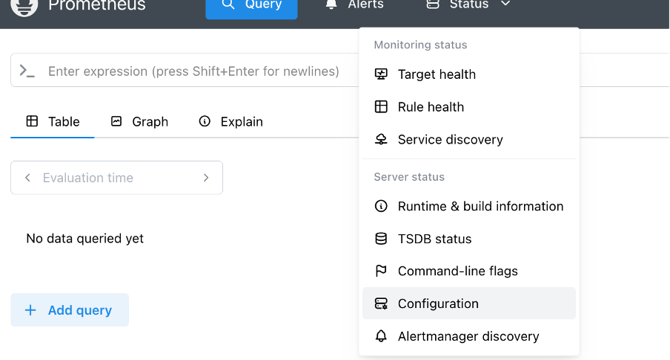Programming News
Self-Learning-Java
112

Image Credit: Self-Learning-Java
Getting Started with Prometheus Configuration File (prometheus.yml)
- The prometheus.yml configuration file is essential for setting up Prometheus to monitor metrics, define alerting rules, and group monitoring jobs.
- The global block in prometheus.yml establishes default values for the entire Prometheus instance, including scrape and evaluation intervals.
- The alerting block specifies where Prometheus should send alerts, usually to Alertmanager for handling notifications.
- The rule_files block lists files containing alerting and recording rules, while the scrape_configs block defines what to scrape and from where.
Read Full Article
6 Likes
Self-Learning-Java
112

Efficiently Querying Multiple Tables with Wildcard Tables in BigQuery
- Wildcard tables in BigQuery allow querying multiple tables with a common schema and naming convention using a concise SQL statement.
- Schema requirements for wildcard tables include having matching or compatible schemas across all tables.
- Using a wildcard expression simplifies queries and improves query manageability for datasets partitioned by time.
- _TABLE_SUFFIX in BigQuery helps filter and differentiate between tables dynamically when using wildcard tables.
- Including _TABLE_SUFFIX in SELECT statements allows identifying the source table for each row in the query results.
- Wildcard tables do not support external tables, views, cached results, or DML statements like INSERT, UPDATE, DELETE, MERGE.
- Utilizing longer prefixes when querying wildcard tables enhances performance by reducing the number of tables scanned.
- Wildcard tables combined with _TABLE_SUFFIX provide a powerful and efficient method for analyzing partitioned datasets and time-based data in BigQuery.
Read Full Article
6 Likes
Medium
392

Image Credit: Medium
Why your terminal is boring and what to use instead
- Using the default terminal that came with your distro is like showing up to a boss fight with a wooden sword.
- Modern terminals in 2025 offer GPU-accelerated rendering, AI-based autocomplete, and hyperconfigurable shells.
- Upgrade to modern Linux terminals for speed, beauty, and customization, enhancing your workflow and comfort.
- Features of modern terminals include full custom theming, translucency, GPU-accelerated rendering, and coding ligatures.
- Popular modern terminals include Kitty, Warp, Alacritty, Tabby, and WezTerm, each offering unique features for different user preferences.
- There's no single 'best terminal,' only the one that suits your needs and preferences.
- Suggestions for terminal setups include using zsh or fish, Nerd Fonts, and tools like Prezto or Starship for customization.
- Exploration of various modern terminals and tools can lead to a faster and more enjoyable terminal experience.
- Switching to a modern terminal setup is easier than it seems, usually just requiring a one-liner or package manager installation.
- Customizing your terminal can improve productivity and make tasks more enjoyable, without needing advanced terminal knowledge.
Read Full Article
23 Likes
Dev
388

Image Credit: Dev
Detecting SSH Brute Force Attacks with Python: Building a Simple Monitor
- Brute force SSH attacks pose a common threat to internet-exposed servers by guessing login credentials.
- Python can be used to detect brute force attacks by monitoring authentication logs and tracking failed login attempts.
- Building a Python-based SSH brute force monitor strengthens Python skills and understanding of security threats.
- Monitoring SSH authentication logs helps detect abuse patterns like multiple failed login attempts from the same IP.
- Python scripts can analyze log files, extract relevant information using regular expressions, and track failed attempts.
- The monitoring logic involves identifying failed login entries, counting attempts per IP, and flagging suspicious activity.
- Enhancements to the monitor can include features like GeoIP lookup, whitelisting, firewall integration, and email alerts.
- By adding features like time window tracking, concurrency, and success correlation, the monitor becomes more powerful.
- Understanding attack origin, tactics, and frequency is key to improving response strategies against brute force attacks.
- Building an SSH brute force monitor is a valuable project to enhance Python skills and gain practical cybersecurity experience.
Read Full Article
23 Likes
Discover more
- Software News
- Web Design
- Devops News
- Open Source News
- Databases
- Cloud News
- Product Management News
- Operating Systems News
- Agile Methodology News
- Computer Engineering
- Startup News
- Cryptocurrency News
- Technology News
- Blockchain News
- Data Science News
- AR News
- Apple News
- Cyber Security News
- Leadership News
- Gaming News
- Automobiles News
Dev
266

Image Credit: Dev
Separating Logic from UI in React: A Comparison with Angular Services
- Angular services act as a middle layer between business logic and UI, while React offers architectural freedom in separating logic and UI.
- Angular services use dependency injection for sharing state and behavior, whereas React allows separating logic through various approaches like Headless Components, Custom Hooks, Context API, and Declarative Composition.
- An example in React demonstrates how the Parent component provides store data to the Child component, showcasing the benefits of separating logic and UI for scalability.
- While Angular utilizes services with dependency injection, React provides flexibility in separating logic using different patterns, ultimately allowing developers to build architecture suited to their application's needs.
Read Full Article
16 Likes
Dev
320

Image Credit: Dev
Hands-On: Building a High-Performance Message Queue in Go (Inspired by NSQ)
- Message queues are vital for distributed systems, and the article explores building a high-performance message queue in Go inspired by NSQ from Bitly.
- The tutorial focuses on learning by doing and customization, targeting developers with Go experience interested in distributed systems.
- NSQ's lightweight design and essential components like nsqd, nsqlookupd, and nsqadmin are highlighted for their simplicity and speed.
- The article delves into designing a message queuing system in Go, covering topics, channels, message flow, and leveraging Go's concurrency features.
- Topics, channels, persistence, consumers, delayed delivery, and optimization tips like bigger buffers and async persistence are discussed in detail.
- Real-world use cases for log collection and async task processing are presented, along with practical solutions and optimization techniques.
- Best practices for handling concurrency, errors, and monitoring in Go projects are shared to ensure efficient and resilient queue operations.
- Common pitfalls like memory leaks, persistence challenges, and duplicate messages are addressed with solutions and coding patterns.
- The article wraps up by summarizing the built NSQ-inspired queue, suggesting next steps for enhancements, and reflecting on the learning journey.
Read Full Article
19 Likes
Dev
248

Image Credit: Dev
Mastering `useMemo` and `useCallback` in React: A Deep Dive
- Two powerful hooks in React, useMemo and useCallback, help optimize rendering behavior, avoid unnecessary recalculations, and manage referential integrity.
- useMemo memoizes the result of a computation to avoid recomputation when dependencies change. useCallback memoizes the function reference itself to prevent recreation on every render.
- A real-world example in the article demonstrates using useMemo and useCallback for optimizing heavy calculations, like Fibonacci, and preventing unnecessary function recreations.
- Best practices for using useMemo and useCallback include ensuring accurate dependency arrays, using them only when necessary, and combining them to prevent unnecessary re-renders and speed up calculations.
Read Full Article
14 Likes
Hackernoon
311

Image Credit: Hackernoon
A Guide on How to Boost Function Performance and Achieve Execution Over 10 Million Times Faster
- The article explores how an arithmetic shortcut discovered by Carl Friedrich Gauss in the 19th century can greatly enhance performance in Swift programming today.
- It compares three methods to calculate the sum of integers from 1 to n: For-In Loop, Reduce Method, and Gauss's Formula, where Gauss's Formula demonstrates superior efficiency.
- By measuring execution times for n = 1,000,000, the article demonstrates how Gauss's Formula outperforms the other methods significantly.
- Big-O notation is discussed to evaluate algorithm efficiency in terms of input size, highlighting Gauss's Formula's constant-time complexity of O(1) as highly efficient.
- The performance comparison shows that Gauss's Formula completes in nanoseconds, making it over 10 million times faster than the For-In Loop and Reduce Method for n = 1,000,000.
- Real-world applications of Gauss's Formula include calculating cumulative scores in a gaming leaderboard and finding missing numbers in sequences, showcasing its practical utility.
- The article emphasizes how leveraging smarter algorithms like Gauss's Formula not only improves performance but also enhances scalability for various computational challenges.
- Gauss's Formula proves to be highly beneficial in optimizing code and reducing time complexity from O(n) to O(1), providing valuable insights for developers seeking efficient solutions.
- The article concludes by highlighting the enduring relevance and impact of ancient mathematical insights in modern programming practices.
Read Full Article
18 Likes
Spring
90

Image Credit: Spring
Your First Spring AI 1.0 Application
- Spring AI has been introduced in the Spring Initializr, making it an exciting time to be a Java and Spring developer, especially in the AI space.
- AI integration with Spring-based workloads is essential, focusing on system prompts, stateless models, collaborating with isolated sandbox models, utilizing prompt stuffing wisely, and dealing with chat model hallucinations using evaluators.
- Spring AI simplifies AI development for Spring developers by offering portable service abstractions, Spring Boot starters, configuration properties, and supporting technologies like virtual threads, GraalVM native images, and Micrometer.
- The article discusses building an application to facilitate dog adoptions using Spring Initializr, including dependencies like PgVector, GraalVM Native Support, Actuator, Data JDBC, JDBC Chat Memory, PostgresML, Devtools, and Web.
- Instructions are provided for setting up the PostgreSQL database and specifying configurations in the application.properties file.
- The article covers implementing features like a ChatClient for fielding user questions, utilizing chat memory for persistence, and using advisors for pre- and post-processing model requests.
- The usage of retrieval augmented generation (RAG) with vector stores, structured output, local tool calling, and integrating with Model Context Protocol (MCP) for remote HTTP-based services are discussed.
- Further topics include securing the application with Spring Security, ensuring scalability with virtual threads, creating GraalVM native images, Dockerizing the application, and leveraging observability for monitoring system resources.
- The article concludes by highlighting the production readiness of the AI application developed using Spring AI, Claude, and PostgresSQL, and suggests exploring Spring Initializr to begin developing similar applications.
Read Full Article
5 Likes
Dev
419

Image Credit: Dev
Mastering `useImperativeHandle` in React: A Step-by-Step Guide for Experts
- useImperativeHandle is a React hook that allows functional components to expose imperative methods to parent components.
- It provides precise control over what functionality to expose, keeping component implementation encapsulated.
- Common use cases include focus, blur, or scroll methods on custom input components, animations controlled by parent, and reset or submit methods in form components.
- Mastering useImperativeHandle is key to fine-grained component interaction in React, enabling clean and reusable APIs without compromising encapsulation.
Read Full Article
25 Likes
Dev
203

Image Credit: Dev
Step-by-step guide to host your Django backend API on a Vps Server (Contabo)
- Point the Subdomain to Your Contabo Server (DNS Settings) by creating an A Record for the subdomain with the public IP.
- Install Required Packages on Contabo (Ubuntu) like python3-pip, python3-venv, nginx, git, and gunicorn.
- Clone your Django app to the server, set up virtual environment, install requirements, run migrations and collect static files.
- Configure Gunicorn, set up a Systemd service, configure Nginx for the subdomain, and optionally set up HTTPS with Let’s Encrypt.
Read Full Article
12 Likes
Dev
230

Image Credit: Dev
⚠️ False Sharing in Go — The Hidden Enemy in Your Concurrency
- False sharing can significantly impact concurrent programs' performance on multi-core CPUs by causing unnecessary synchronization between cores.
- In Go, false sharing occurs when separate goroutines update fields that are located in the same CPU cache line, leading to degraded parallelism benefits.
- Padding struct fields to separate them across cache lines can mitigate false sharing issues and improve performance in concurrent programs.
- Measuring false sharing problems can be done using tools like go test with benchmarking and Linux's perf tool to analyze cache-references and cache-misses.
- Addressing false sharing is essential for achieving efficient core-level coordination and maximizing parallelism in Go programs.
- HP-MP Story: The author discovered false sharing while developing a MMORPG in Go, where separate fields in a struct unexpectedly shared the same cache line.
- Takeaways include considering padding, reordering fields, or struct splitting to resolve false sharing issues and optimize performance in concurrent Go programs.
- Profiling tools like perf can help in identifying and resolving false sharing problems in Go concurrency for improved efficiency.
- Understanding CPU behavior and how false sharing affects code execution can lead to better performance optimizations in Go programs.
- Test, measure, and optimize your code to prevent or tackle false sharing challenges and enhance the efficiency of multi-core processing in Go applications.
Read Full Article
13 Likes
Medium
144

Image Credit: Medium
Real-time Networking in Slipstream
- Slipstream uses Client-Side Prediction and Server Reconciliation for server-authoritative networking.
- FishNet is employed as the high-level networking API in Unity.
- Prediction is implemented through replicate and reconcile methods using FishNet.
- Replicate method handles player input mutates the state on both server and client.
- Reconcile method updates the client state based on the server's state.
- Clients run slightly in the 'future' compared to the server to mitigate latency.
- Entity interpolation is used to smooth out visual discrepancies due to server-reconciliation.
- Interpolation is adaptively employed after an unpredictable input triggers server-reconciliation.
- Linear interpolation is used to adjust player positions during visual updates.
- Networking for real-time physics-based games like Slipstream involves complex strategies and trade-offs.
Read Full Article
8 Likes
Dev
90

Image Credit: Dev
Why Quadify Is the Ultimate Blender Add-on for Tri-to-Quad Conversion
- Quadify is a top Blender add-on for converting triangle-based meshes to clean quad topologies, catering to 3D artists, game developers, and animators.
- Quads offer benefits like better deformation, improved UV mapping, enhanced subdivision, and industry standard compatibility, making Quadify crucial for efficient workflows.
- Key benefits of Quadify include lightning-fast automation, real-time poly count feedback, clean topology, easy integration with Blender, enhanced productivity, and cost-effectiveness.
- In the era of automation, Quadify meets the demand for speed, supports AI and procedural pipelines, optimizes for game engines, empowers small teams, and future-proofs workflows.
- Getting started with Quadify involves purchasing from the Blender Marketplace, installing in Blender, accessing the panel in the 3D Viewport, and exploring advanced features.
- Quadify finds applications in game development, animation, architectural visualization, VR/AR development, and 3D printing, offering versatility and efficiency.
- Blender artists love Quadify for its time-saving features, clean quad meshes, and ease of use, as evidenced by positive reviews from the community.
- Quadify elevates Blender workflows with its automation, speed, and professional results, making it a valuable tool for modern 3D projects and workflows.
- Integrate Quadify today to enhance your 3D modeling experience and optimize your assets for various applications, staying ahead in the realm of 3D automation.
Read Full Article
5 Likes
Dev
72

Image Credit: Dev
Building a Gold (XAUUSD) Trend Tracker with Python and SQLite
- XAUUSD represents the cost in US dollars to purchase one ounce of gold in Forex trading.
- Gold can be bought physically at banks or from dealers and is often used by governments to safeguard currency value.
- XAUUSD is not tied to any specific nation, economy, or business, making it globally significant.
- The project involves building a Gold (XAUUSD) trend tracker using Python and SQLite for data storage.
- The extraction, transformation, and loading (ETL) process is crucial for analyzing and visualizing data.
- TwelveData forex API is used to extract raw XAUUSD data in JSON format.
- Pandas library is utilized for data transformation, including calculating moving averages and labeling market conditions.
- SQLite is employed for loading the transformed data into a database for further analysis or presentation.
- The ETL pipeline involves retrieving data, transforming it, and storing it in a SQLite database for easy access.
- The project showcases how to handle financial data from APIs, manipulate it, and store it efficiently for analysis.
Read Full Article
4 Likes
For uninterrupted reading, download the app